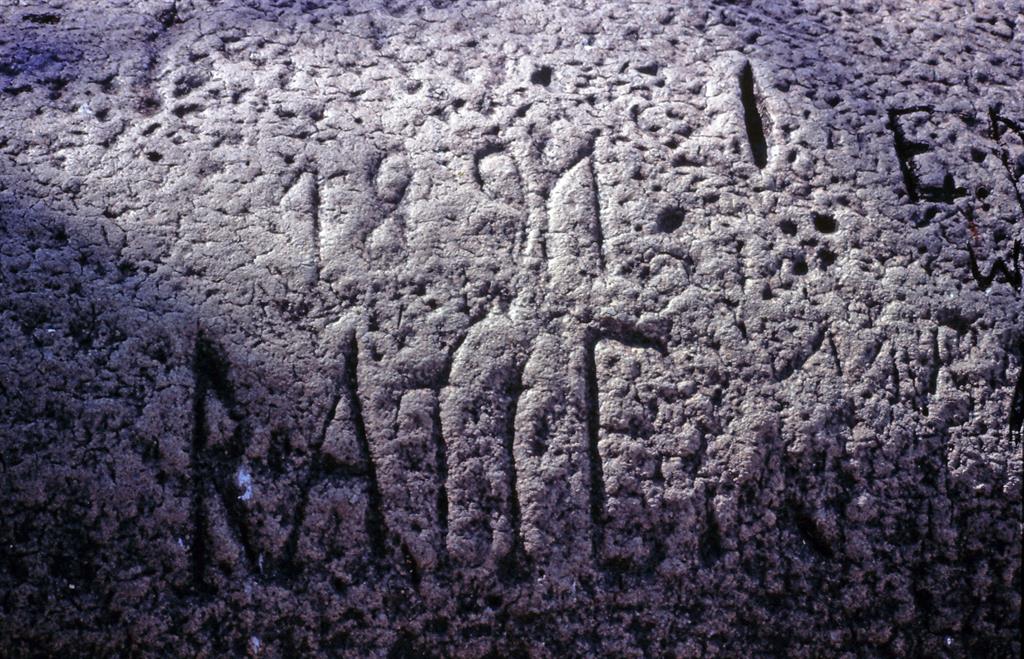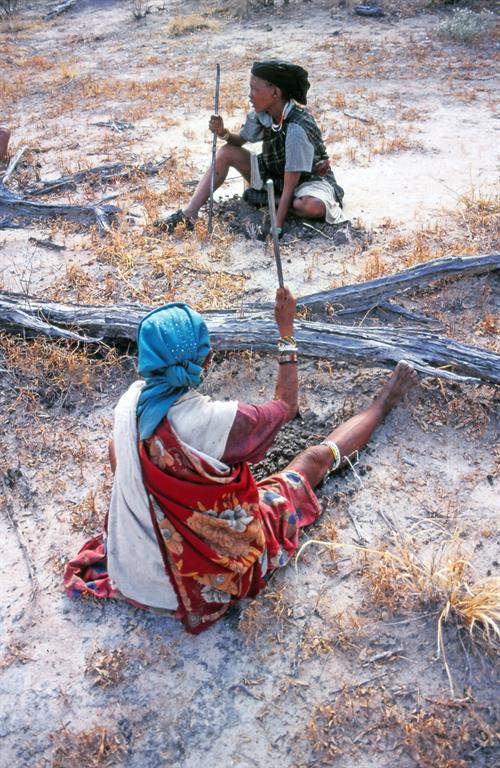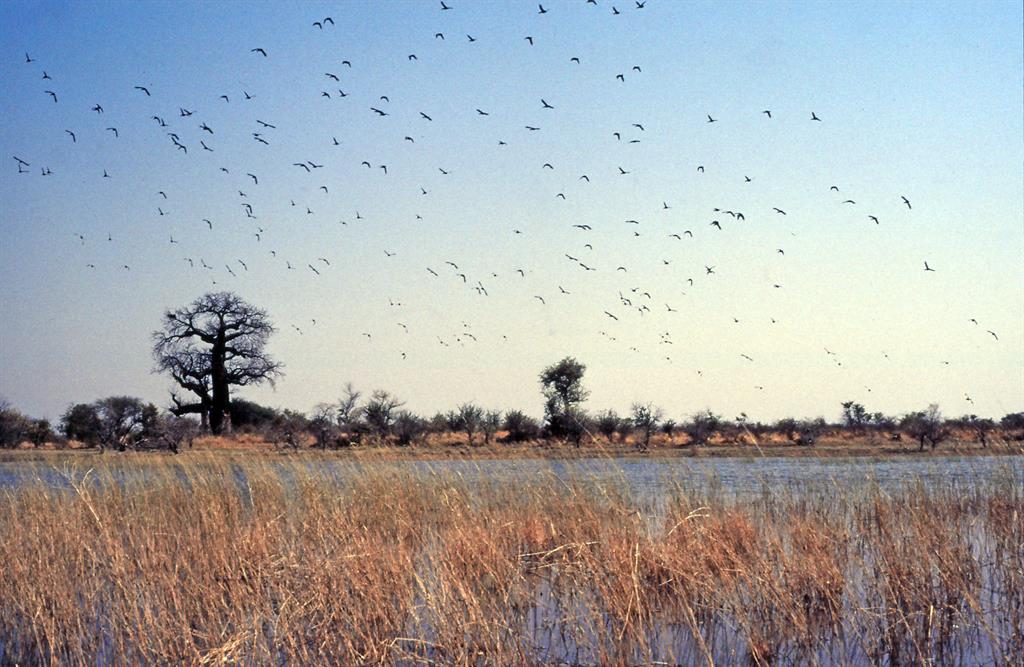EXPLORING THE LAND OF THE SAN
WILLIE OLIVIER
The appeal of the area commonly referred to as Bushmanland lies mainly in its wilderness atmosphere, game-viewing and the opportunity to interact with the Ju/'hoansi (San) people who have lived here for thousands of years.
Once you have passed through the Rooidag Veterinary Control Post on the C44 to Tsumkwe, you enter the N#a-Jaqna Conservancy (formerly Western Bushmanland), which is named after the Buffalo Thorn Tree. The landscape here is dominated by Kalahari sand with broadleaf and thorn tree woodlands, but as you continue further east, the scenery gives way to a wilderness of woodlands, ancient baobabs, seasonal pans and a variety of game species.
About 40 km before reaching the settlement of Tsumkwe you enter the Nyae Nyae Conservancy, formerly known as Eastern Bushmanland. Tsumkwe, the only large settlement in the area, developed around the administrative post which was established in 1959. Its Ju/'hoan name means ‘poison arrow.’ It is the southern gateway to the Khaudum National Park and the network of tracks radiating from the settlement.
Wildlife numbers have increased substantially since the Nyae Nyae Conservancy was declared and game-viewing is one of the major drawcards. Nyae Nyae is a stronghold for Roan Antelope and Wild Dog, while the number of resident and migrating Elephant can reach up to 1 500. Kudu, Gemsbok, Blue Wildebeest, Springbok and Red Hartebeest are among the species most likely to be seen, while Eland and Giraffe are less frequently encountered. Lion, which has an estimated population of ten, Leopard and Spotted Hyaena represent the large predators.
The conservancy is punctuated by numerous seasonal pans which offer interesting opportunities to tick wetland birds, including Lesser and Greater Flamingo, as well as a variety of waterfowl, heron and egret species during the rainy season. The grasslands around the pans and the woodlands can also be productive for birders, while a rich diversity of raptors have been recorded.
Baobab trees punctuate the woodlands, but two of the ancient giants that once attracted visitors, the Grootboom and the Holboom, have collapsed. Trunks of the Dorslandtrek Baobab and the Lêboom have also collapsed.
What is wilderness to some is home to others and during your Bushmanland visit you can learn more about the culture and way of life of the Ju/'hoansi people. The Living Culture Foundation Namibia has established two living museums in the area. The Living Museum of the Ju/'Hoansi-San is signposted 1 km east of the veterinary fence on the C44, while the Little Hunter’s Museum of the Ju/'Hoansi-San is 23 km north of Tsumkwe on the D3315 to the Khaudum National Park. The turnoff to the Omatako Valley Rest Camp is signposted 11 km east of the veterinary fence. It was started as a community project by 30 villagers from Kandu, Grashoek, Kanovlei and Omatako in 1996.
A variety of interactive programmes are offered at these initiatives. Options range from short bush walks, collecting veld food and cultural activities such as singing and dancing to full-day activities. During the bush walk the Ju/'hoansi will demonstrate their excellent tracking skills and introduce you to the bush food they collect. At the Little Hunter’s Museum you can also join the Ju/'Hoansi on a hunt.
This is strictly 4x4 territory and driving conditions vary according to the season. Expect deep, loose sand which can be tough to negotiate in dry conditions. Large areas are inundated during the rainy season when there is a real possibility of getting stuck in the black cotton soil mud.
Basic supplies can be bought in Tsumeb, but you need to be self-sufficient for the duration of your visit. Petrol and diesel are sold at Tsumeb, but as it is advisable to confirm availability with the TUCSIN Tsumkwe Lodge.
Camping facilities are available at the Omatako Valley Rest Camp, as well as the Living Museum of the Ju/'Hoansi-San and the Little Hunter’s Museum of the Ju/'Hoansi-San. Accommodation in Tsumkwe is available at the TUCSIN Tsumkwe Lodge which has 22 twin cabins with en-suite shower and toilet, six campsites with electrical points, tap water, braai facilities and communal ablutions. Facilities include a restaurant, bar and a small swimming pool.
The appeal of the area commonly referred to as Bushmanland lies mainly in its wilderness atmosphere, game-viewing and the opportunity to interact with the Ju/'hoansi (San) people who have lived here for thousands of years.
Once you have passed through the Rooidag Veterinary Control Post on the C44 to Tsumkwe, you enter the N#a-Jaqna Conservancy (formerly Western Bushmanland), which is named after the Buffalo Thorn Tree. The landscape here is dominated by Kalahari sand with broadleaf and thorn tree woodlands, but as you continue further east, the scenery gives way to a wilderness of woodlands, ancient baobabs, seasonal pans and a variety of game species.
About 40 km before reaching the settlement of Tsumkwe you enter the Nyae Nyae Conservancy, formerly known as Eastern Bushmanland. Tsumkwe, the only large settlement in the area, developed around the administrative post which was established in 1959. Its Ju/'hoan name means ‘poison arrow.’ It is the southern gateway to the Khaudum National Park and the network of tracks radiating from the settlement.
Wildlife numbers have increased substantially since the Nyae Nyae Conservancy was declared and game-viewing is one of the major drawcards. Nyae Nyae is a stronghold for Roan Antelope and Wild Dog, while the number of resident and migrating Elephant can reach up to 1 500. Kudu, Gemsbok, Blue Wildebeest, Springbok and Red Hartebeest are among the species most likely to be seen, while Eland and Giraffe are less frequently encountered. Lion, which has an estimated population of ten, Leopard and Spotted Hyaena represent the large predators.
The conservancy is punctuated by numerous seasonal pans which offer interesting opportunities to tick wetland birds, including Lesser and Greater Flamingo, as well as a variety of waterfowl, heron and egret species during the rainy season. The grasslands around the pans and the woodlands can also be productive for birders, while a rich diversity of raptors have been recorded.
Baobab trees punctuate the woodlands, but two of the ancient giants that once attracted visitors, the Grootboom and the Holboom, have collapsed. Trunks of the Dorslandtrek Baobab and the Lêboom have also collapsed.
What is wilderness to some is home to others and during your Bushmanland visit you can learn more about the culture and way of life of the Ju/'hoansi people. The Living Culture Foundation Namibia has established two living museums in the area. The Living Museum of the Ju/'Hoansi-San is signposted 1 km east of the veterinary fence on the C44, while the Little Hunter’s Museum of the Ju/'Hoansi-San is 23 km north of Tsumkwe on the D3315 to the Khaudum National Park. The turnoff to the Omatako Valley Rest Camp is signposted 11 km east of the veterinary fence. It was started as a community project by 30 villagers from Kandu, Grashoek, Kanovlei and Omatako in 1996.
A variety of interactive programmes are offered at these initiatives. Options range from short bush walks, collecting veld food and cultural activities such as singing and dancing to full-day activities. During the bush walk the Ju/'hoansi will demonstrate their excellent tracking skills and introduce you to the bush food they collect. At the Little Hunter’s Museum you can also join the Ju/'Hoansi on a hunt.
This is strictly 4x4 territory and driving conditions vary according to the season. Expect deep, loose sand which can be tough to negotiate in dry conditions. Large areas are inundated during the rainy season when there is a real possibility of getting stuck in the black cotton soil mud.
Basic supplies can be bought in Tsumeb, but you need to be self-sufficient for the duration of your visit. Petrol and diesel are sold at Tsumeb, but as it is advisable to confirm availability with the TUCSIN Tsumkwe Lodge.
Camping facilities are available at the Omatako Valley Rest Camp, as well as the Living Museum of the Ju/'Hoansi-San and the Little Hunter’s Museum of the Ju/'Hoansi-San. Accommodation in Tsumkwe is available at the TUCSIN Tsumkwe Lodge which has 22 twin cabins with en-suite shower and toilet, six campsites with electrical points, tap water, braai facilities and communal ablutions. Facilities include a restaurant, bar and a small swimming pool.










Kommentar
Allgemeine Zeitung
Zu diesem Artikel wurden keine Kommentare hinterlassen